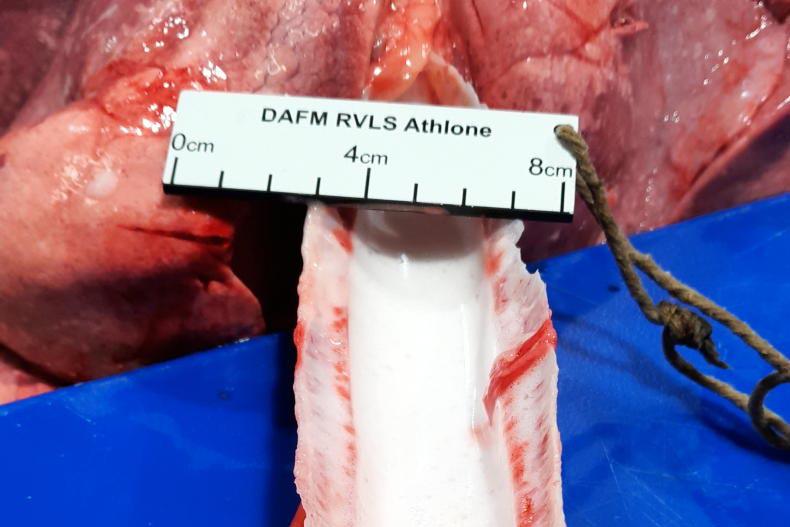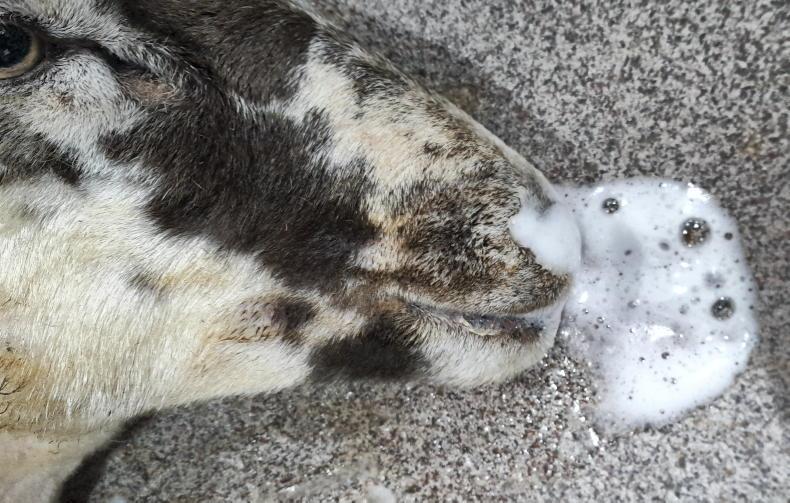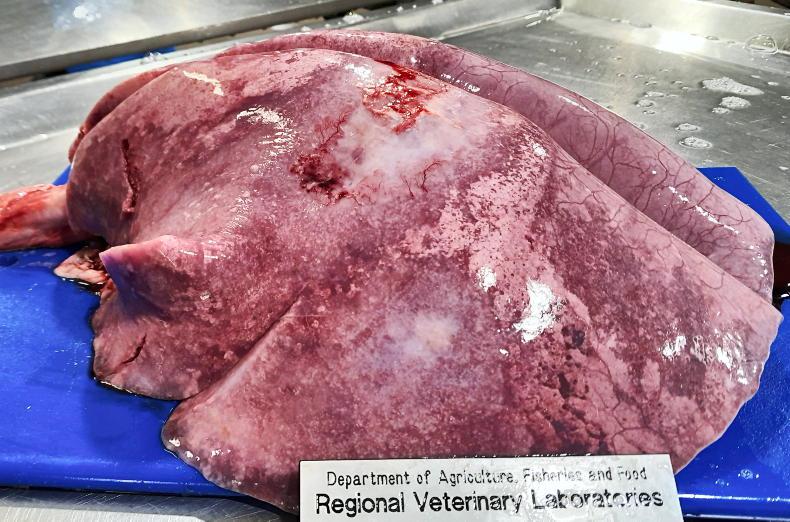The disease ovine pulmonary adenocarcinoma (OPA) or Jaagsiekte sheep retrovirus as it is also known has been identified in the sheep flock in Tullamore
Farm.
The so-called ‘iceberg disease’ was identified in post-mortems carried out on two ewes which died in recent weeks.
The first ewe was a prime candidate for the disease having demonstrated classical symptoms in the weeks leading up to her death.

OPA in ewe on Tullamore Farm.
The ewe began to lose condition despite being on a diet capable of maintaining condition in her flock comrades and was also treated for pneumonia-like symptoms.
Manager Shaun Diver also reports that the ewe had started to become more lethargic when flocked and was continually the slowest ewe in the flock.
Disease risk
The farm has long known that it faced a risk of OPA given a high percentage of replacements have been purchased since the flock was established. No symptoms were evident before now.
Once the ewe started to become more lethargic she was housed to ensure that a post-mortem would be possible as with an active population or predators any sheep which dies overnight can be quickly attacked.
The ewe died on a Friday evening and the farm’s vet Donal Lynch, Slieve Bloom Veterinary, collected the lungs and trachea which were delivered to Athlone Regional Veterinary Laboratory on the following Monday morning.
The second ewe which died and was suspect of OPA displayed signs of sickness for a much shorter period of time.
The ewe in question was in good body condition but again developed pneumonia-like symptoms which straight away gave rise to suspicions of OPA.
Slieve Bloom Veterinary carried out thoracic ultrasound scanning of the ewe’s lungs and could immediately see that its lungs were badly damaged.

OPA in ewe on Tullamore Farm.
The ewe died last Wednesday and was delivered for post-mortem on Thursday morning with the preliminary findings identifying OPA.
The ewe also displayed more classical symptoms of OPA in the final period before her death and was coughing and also exhibiting a frothy discharge from her nostrils.
This is reflected in the first photo of the ewe which shows fluid flowing from its nostrils.
Disease presentation
Many of the disease symptoms are touched on already but to recap and expand the first signs of disease are often sheep exhibiting a soft cough when flocked. As the disease worsens sheep struggle to keep pace with their flock comrades when flocked and in the latter stages of disease can exhibit a frothy discharge from their nostrils.
There is a test known as the wheelbarrow test which in the past has sometimes been used to distinguish it from other diseases whereby the back legs of animals are raised up leading to fluid leaking out the animal’s nostrils. This test is not recommended on animal welfare grounds unless a vet is present to euthanise the animal in question. The reason for fluid flowing out the animal’s nostrils is that the disease leads to a tumour developing in the lungs which gradually spreads, limiting the lungs functioning capacity, which in turn leads up to retained fluid in the system.

OPA in ewe on Tullamore Farm.
The top photo on page 55 shows the extent of damage to the lungs while the bottom photo shows a cross-section of a segment of lungs showing how thickened the tissue had become. As expected this level of damage greatly impedes an animal’s ability to breathe and function.
The disease can advance at different rates and generally has an incubation period of three years but industry views indicate this can range anywhere from two months to 11 years depending on the severity of the infection.
A secondary bacterial pneumonia can also develop and is more common in flocks with a significant disease rate. The virus is easily spread through respiratory aerosol (passes through the air), contaminated feeding equipment and also to progeny via colostrum.
Disease identification
Speaking at last week’s Teagasc hill sheep conference in Dungarvan, Co Waterford, Seamus Fagan from the Athlone RVL told farmers the reason OPA is described as an iceberg disease is that it is thought to be under-reported due to the fact that it is difficult to diagnose and many farmers often pass it off as pneumonia or cull underperforming ewes before classical symptoms occur.
The low level of identification is also complicated by the disease showing no immune response and the lack of a commercially available diagnostic blood test. As touched on above thoracic ultrasound scanning to identify the presence of lesions / tumours on the surface of lungs is one option to try and get on top of the disease and reduce the level of prevalence within a flock. This method does have limitations with lesions of greater than 2cm required to denote its presence. The presence of lung abscesses can also complicate its identification. As such scanning is the only real option to try and weed out infected sheep with no treatment possible.
Scanning procedure
There are a number of vets now offering scanning services with a few bodies in Northern Ireland specialising in the practice. Scanning takes place behind the sheep’s shoulders at the non-wooled area. The animals front legs are raised upwards allowing the lungs to be carefully examined.
The procedure used by some is to classify sheep into three classes - confirmed cases, suspect cases and healthy animals. In some flocks suspect cases are rescanned at a later date but this depends on the type of sheep with some farmers opting in particular to cull out older ewes which are suspect and salvage a sale value.

OPA in ewe on Tullamore Farm.
Work in CAFRE’s Greenmount hill flocks and on a number of farms participating in the Teagasc BETTER farm sheep programme shows that ewes can be identified and mortality reduced. Experience through the Northern Ireland Sheep Programme a few years back showed prevalence typically at 2% to 3% but rising to upwards of 8%.
Next steps
With lambing around the corner there is little that can be done in Tullamore Farm at present other than be vigilant of the disease and segregate suspect sheep to limit the chance of disease spread – transmitted from sheep to sheep mainly through respiratory aerosol.
The farm will now revise its health plan working closely with Donal Lynch to address OPA. It is likely that ewes will be scanned later in the year once lambs are weaned. At this stage being able to link suspect ewes to their lambs will allow such lambs to be brought through to slaughter and not retained as flock replacements.
Any fallen ewes will continue to be sent for post-mortem as is the current case with any ewes which die without a known cause.
The disease ovine pulmonary adenocarcinoma (OPA) or Jaagsiekte sheep retrovirus as it is also known has been identified in the sheep flock in Tullamore
Farm.
The so-called ‘iceberg disease’ was identified in post-mortems carried out on two ewes which died in recent weeks.
The first ewe was a prime candidate for the disease having demonstrated classical symptoms in the weeks leading up to her death.

OPA in ewe on Tullamore Farm.
The ewe began to lose condition despite being on a diet capable of maintaining condition in her flock comrades and was also treated for pneumonia-like symptoms.
Manager Shaun Diver also reports that the ewe had started to become more lethargic when flocked and was continually the slowest ewe in the flock.
Disease risk
The farm has long known that it faced a risk of OPA given a high percentage of replacements have been purchased since the flock was established. No symptoms were evident before now.
Once the ewe started to become more lethargic she was housed to ensure that a post-mortem would be possible as with an active population or predators any sheep which dies overnight can be quickly attacked.
The ewe died on a Friday evening and the farm’s vet Donal Lynch, Slieve Bloom Veterinary, collected the lungs and trachea which were delivered to Athlone Regional Veterinary Laboratory on the following Monday morning.
The second ewe which died and was suspect of OPA displayed signs of sickness for a much shorter period of time.
The ewe in question was in good body condition but again developed pneumonia-like symptoms which straight away gave rise to suspicions of OPA.
Slieve Bloom Veterinary carried out thoracic ultrasound scanning of the ewe’s lungs and could immediately see that its lungs were badly damaged.

OPA in ewe on Tullamore Farm.
The ewe died last Wednesday and was delivered for post-mortem on Thursday morning with the preliminary findings identifying OPA.
The ewe also displayed more classical symptoms of OPA in the final period before her death and was coughing and also exhibiting a frothy discharge from her nostrils.
This is reflected in the first photo of the ewe which shows fluid flowing from its nostrils.
Disease presentation
Many of the disease symptoms are touched on already but to recap and expand the first signs of disease are often sheep exhibiting a soft cough when flocked. As the disease worsens sheep struggle to keep pace with their flock comrades when flocked and in the latter stages of disease can exhibit a frothy discharge from their nostrils.
There is a test known as the wheelbarrow test which in the past has sometimes been used to distinguish it from other diseases whereby the back legs of animals are raised up leading to fluid leaking out the animal’s nostrils. This test is not recommended on animal welfare grounds unless a vet is present to euthanise the animal in question. The reason for fluid flowing out the animal’s nostrils is that the disease leads to a tumour developing in the lungs which gradually spreads, limiting the lungs functioning capacity, which in turn leads up to retained fluid in the system.

OPA in ewe on Tullamore Farm.
The top photo on page 55 shows the extent of damage to the lungs while the bottom photo shows a cross-section of a segment of lungs showing how thickened the tissue had become. As expected this level of damage greatly impedes an animal’s ability to breathe and function.
The disease can advance at different rates and generally has an incubation period of three years but industry views indicate this can range anywhere from two months to 11 years depending on the severity of the infection.
A secondary bacterial pneumonia can also develop and is more common in flocks with a significant disease rate. The virus is easily spread through respiratory aerosol (passes through the air), contaminated feeding equipment and also to progeny via colostrum.
Disease identification
Speaking at last week’s Teagasc hill sheep conference in Dungarvan, Co Waterford, Seamus Fagan from the Athlone RVL told farmers the reason OPA is described as an iceberg disease is that it is thought to be under-reported due to the fact that it is difficult to diagnose and many farmers often pass it off as pneumonia or cull underperforming ewes before classical symptoms occur.
The low level of identification is also complicated by the disease showing no immune response and the lack of a commercially available diagnostic blood test. As touched on above thoracic ultrasound scanning to identify the presence of lesions / tumours on the surface of lungs is one option to try and get on top of the disease and reduce the level of prevalence within a flock. This method does have limitations with lesions of greater than 2cm required to denote its presence. The presence of lung abscesses can also complicate its identification. As such scanning is the only real option to try and weed out infected sheep with no treatment possible.
Scanning procedure
There are a number of vets now offering scanning services with a few bodies in Northern Ireland specialising in the practice. Scanning takes place behind the sheep’s shoulders at the non-wooled area. The animals front legs are raised upwards allowing the lungs to be carefully examined.
The procedure used by some is to classify sheep into three classes - confirmed cases, suspect cases and healthy animals. In some flocks suspect cases are rescanned at a later date but this depends on the type of sheep with some farmers opting in particular to cull out older ewes which are suspect and salvage a sale value.

OPA in ewe on Tullamore Farm.
Work in CAFRE’s Greenmount hill flocks and on a number of farms participating in the Teagasc BETTER farm sheep programme shows that ewes can be identified and mortality reduced. Experience through the Northern Ireland Sheep Programme a few years back showed prevalence typically at 2% to 3% but rising to upwards of 8%.
Next steps
With lambing around the corner there is little that can be done in Tullamore Farm at present other than be vigilant of the disease and segregate suspect sheep to limit the chance of disease spread – transmitted from sheep to sheep mainly through respiratory aerosol.
The farm will now revise its health plan working closely with Donal Lynch to address OPA. It is likely that ewes will be scanned later in the year once lambs are weaned. At this stage being able to link suspect ewes to their lambs will allow such lambs to be brought through to slaughter and not retained as flock replacements.
Any fallen ewes will continue to be sent for post-mortem as is the current case with any ewes which die without a known cause.











 This is a subscriber-only article
This is a subscriber-only article










SHARING OPTIONS: